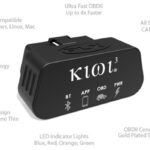The oil service light, a common indicator on your car’s dashboard, is a crucial reminder for routine vehicle maintenance. Typically illuminating after a predetermined mileage or time interval, it signals the need for an oil change and other maintenance checks. While getting your oil changed is essential for engine health, simply changing the oil isn’t enough to turn off this light in many modern vehicles. This is where an OBD scanner becomes an indispensable tool. For DIY car enthusiasts and professional mechanics alike, understanding how to use an OBD scanner to reset the oil service light can save time and money, ensuring your vehicle maintenance schedule is accurately tracked.
Understanding the Oil Service Light
The oil service light, sometimes also referred to as a maintenance light, is part of your vehicle’s onboard diagnostics system. It’s designed to prompt you to perform routine maintenance, primarily an oil change, based on manufacturer-recommended intervals. This system is not directly monitoring the quality or level of your oil. Instead, it operates based on mileage, time, and sometimes driving conditions, triggering the light as a reminder. Ignoring this light for extended periods is not advisable, as timely oil changes are vital for engine lubrication and longevity.
Why Resetting the Oil Service Light is Important After an Oil Change
After you’ve diligently performed an oil change, your vehicle’s computer system still needs to be informed that the service has been completed. The oil service light won’t automatically turn off just because you’ve changed the oil. Resetting the light is crucial for several reasons:
- Accurate Maintenance Tracking: Resetting the light ensures your vehicle accurately tracks the next service interval. Without resetting, the light will remain on, potentially leading to confusion about when the next service is actually due.
- Avoiding Over-Servicing: Conversely, if you ignore the lit service light and continue driving without resetting after an oil change, you might prematurely perform another service, leading to unnecessary expenses.
- System Functionality: In some vehicles, the service light is linked to other maintenance reminders and onboard systems. Resetting it ensures the entire system functions correctly and provides accurate information.
Alt: Oil service light illuminated on a car dashboard, indicating maintenance is needed.
Choosing the Right OBD Scanner for Oil Service Reset
To reset your oil service light, you’ll need an OBD (On-Board Diagnostics) scanner. These devices connect to your car’s OBD-II port, typically located under the dashboard, and allow you to communicate with the vehicle’s computer system. When it comes to resetting the oil service light, different types of OBD scanners offer varying levels of functionality:
- Basic OBD-II Scanners: These are primarily designed for reading and clearing generic trouble codes related to the engine and emissions systems. While some basic scanners might offer a service light reset function, it’s not a standard feature across all models. Check the scanner’s specifications to confirm if it includes this capability.
- Service Reset Tools: These are specialized tools designed specifically for resetting service lights, including oil service, tire pressure, and brake maintenance lights. They often have a simpler interface and are more focused on these specific reset functions.
- Professional-Grade OBD-II Scanners: These advanced scanners offer comprehensive diagnostic capabilities, including reading detailed trouble codes, performing advanced system tests, and definitely include service reset functions for various systems, including oil service. While more expensive, they provide the most reliable and versatile solution for service light resets and broader vehicle diagnostics.
For simply resetting an oil service light, a mid-range service reset tool or a professional-grade scanner is usually recommended to ensure compatibility and successful reset.
Step-by-Step Guide to Resetting Your Oil Service Light with an OBD Scanner
While the exact steps can vary slightly depending on your specific OBD scanner and vehicle model, here’s a general guide to resetting your oil service light:
- Locate the OBD-II Port: Turn off your vehicle’s ignition and locate the OBD-II port. It’s usually found under the dashboard on the driver’s side.
- Connect the OBD Scanner: Plug your OBD scanner into the OBD-II port. Ensure it’s securely connected.
- Turn on the Ignition (but not the engine): Turn the ignition key to the “ON” position. This powers up the car’s electronics and allows the scanner to communicate with the system.
- Power on the OBD Scanner: Turn on your OBD scanner and allow it to establish a connection with your vehicle. This may take a few moments.
- Navigate to Service Reset or Oil Reset Function: Using your scanner’s interface, navigate to the “Service Reset,” “Oil Reset,” or “Maintenance Reset” menu option. Refer to your scanner’s user manual if needed.
- Follow On-Screen Prompts: The scanner will typically provide on-screen instructions. You might need to select your vehicle’s make, model, and year. Then, select “Oil Service Reset” or a similar option.
- Confirm Reset: The scanner will usually ask for confirmation before performing the reset. Confirm your selection to proceed.
- Wait for Confirmation: The scanner will communicate with your vehicle’s computer to reset the oil service light. Wait for the scanner to display a confirmation message, such as “Reset Successful” or “Service Reset Complete.”
- Turn off Ignition and Disconnect Scanner: Once the reset is confirmed, turn off the ignition, remove the OBD scanner from the OBD-II port.
- Start Your Vehicle and Check: Start your vehicle’s engine to verify that the oil service light has been successfully reset and is no longer illuminated.
Alt: Hand plugging an OBD scanner into a car’s OBD-II port under the dashboard.
When You Might Need Professional Help
While resetting the oil service light with an OBD scanner is generally straightforward, there are situations where you might encounter difficulties or require professional assistance:
- Scanner Incompatibility: Your OBD scanner might not be compatible with your specific vehicle model or may not support the oil service reset function for your car.
- Reset Failure: You follow the reset procedure, but the oil service light remains illuminated. This could indicate an issue with the scanner, the vehicle’s computer system, or a genuine underlying problem that’s triggering the light.
- Recurring Light: The oil service light resets temporarily but comes back on shortly after. This often points to an actual fault or sensor issue that needs professional diagnosis and repair.
- Unfamiliar with OBD Scanners: If you are not comfortable using electronic tools or navigating menu-driven interfaces, seeking help from a mechanic might be a more comfortable option.
In such cases, consulting a qualified mechanic is advisable. They have professional-grade diagnostic tools and expertise to accurately diagnose and resolve any issues related to your vehicle’s service light and overall maintenance.
Conclusion
Resetting your oil service light after an oil change using an OBD scanner is a valuable skill for car owners who prefer DIY maintenance. It ensures accurate service tracking, prevents over-servicing, and can save you trips to the mechanic just for a simple reset. By understanding the process and choosing the right OBD scanner, you can confidently manage this aspect of your vehicle maintenance, keeping your car running smoothly and efficiently. Investing in an OBD scanner can be a worthwhile decision for any car owner looking to take a more proactive approach to vehicle care.


